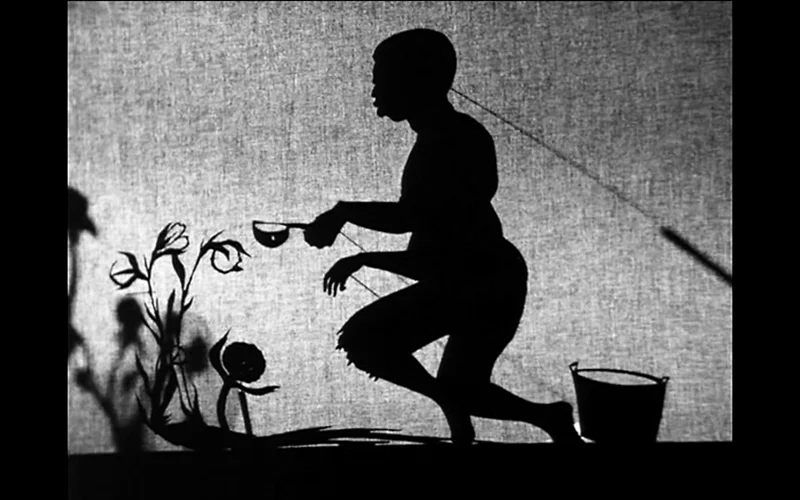Jan Estep, “Kara Walker,” Modern Painters, July/August 2007, 81.
Kara Walker
Kara Walker, still from 8 Possible Beginnings or: The Creation of African-America, a Moving Picture by Kara E. Walker, 2005. 16mm film and video transferred to DVD, 15 min 57 sec. Courtesy the artist and Sikkema Jenkins & Co, New York.
Much has been written…
about Kara Walker’s work, and for good reason, because she supplies observers with plenty of material: the history of American slavery and its legacy, the oppressive brutalization of blacks and children, the near-pornographic impact of her cut-paper silhouettes, the representation of negative racial stereotypes, the confusion of sex and power, desire and hate, pride and self-loathing.
For good or bad, Walker is one of those artists whose work I can’t view without the critical discourse about her resounding in my head. And because her primary concern is race, I feel a moral imperative to take this discourse to heart. This obligation, however, makes it difficult to engage the work viscerally. Usually I prefer to have an analytical or intellectualized response to art (and I don’t mean to reify a simply mind-body dichotomy). But I get the sense the artist wants me to feel something more directly: outrage, offense, titillation, shame, guilt. Or at least surprise that, as she says, such “a Goody Two-shoes like [her] can have all this going on in her head.”
Noting my tendency to dwell on the interpretations of Walker’s work rather than engage it emotionally, I deliberately returned again to this first major US survey with the intent of trying to access it on a more personal level. How was I, as a white female subject, simultaneously attracted to and repelled by the work? The title of the survey, “My Complement, My Enemy, My Oppressor, My Love,” suggests a range of ways to relate to the protagonists in Walker’s scenarios. But who is speaking here? Filtered through the first-person possessive “my,” I am left with three choices: to own these titles as my own, to attribute them to the character of the artist herself from a black female perspective, or to stand outside altogether as the target of these terms of endearment or entrapment.
bell hooks pointed out the way that race, gender, and class intertwine, challenging the notion that one could analyze sexism in isolation from these other factors. Yet when viewing Walker’s work, I am constantly asking myself whether or not being a woman is more central to my self-conception than being white. I could identify with the artist’s female point of view, but her blackness pushes me out. Or I could identify with Walker’s portrayal of the white male oppressor, but his maleness pushes me out. If I reject both of these positions and turn to the few white women she portrays, I am effectively sidelined as a minor character. It’s the white men and blacks who have all the fun, and consequently all the drama and torture. Thus, for the most part, if a white female viewer wants to engage the narratives, she has to cross racial and gendered lines. This movement in and out of the broad categories is central to Walker’s project.
Looking at the work, I didn’t find the play of these categories particularly alienating. In fact, I didn’t consciously focus on them until I watched 8 Possible Beginnings or: The Creation of African-America, a Moving Picture by Kara E. Walker (2005). During the animated video’s eight vignettes, a mythological tale unfolds, involving Africans being shipped across the ocean, arriving at a place called Motherland, and helping to build the cotton industry in America; the video ends with a violent retelling of an Uncle Remus story. Significantly the main relationship occurs between two men, a muscular black slave who is called King Cotton and a skinny, weakened white slave owner. After their prolonged sexual encounter, King Cotton becomes pregnant and gives birth to a young cotton plant, which he tends in the field. Women are typically treated—even in Walker’s own work—as sexual objects, but in this case they are removed from the equation. The relationship shows how useless women are: a classic male co-optation of the birthing metaphor—women simply as vessels for male seed—taken one step further by the elimination of the female body altogether. In this version, birthing is all about reproducing the (white) male phallic order. The image of King Cotton’s love-child leaving his body at birth confirms this: the young cotton plant initially projects looking like a tiny penis, mirroring the thin white penis of the slave owner.
The first time I watched 8 Possible Beginnings I was alone, and attended to my own engagement with the work. I felt a sense of suspicion when the Motherland, portrayed as a giant black female, greedily gobbles up the Africans and shits them out onto a field. Then cynicism, mixed with relief, that women were no longer necessary for childbirth. And sadness when a young slave girl whispers, “I wish I were white.” But during each subsequent viewing, a lone white male viewer watched with me. When King Cotton and the slave owner got it on in the fields, I wondered how the stranger next to me felt. Was he angry or excited? Humiliated or objectified? Did he understand how the tables had been turned? Was watching this going to make him think or act differently? The strength of Walker’s work lies in its ability to get us to examine the lingering contradictions left when one group of people systematically dominates another. To the extent that her work also enhances our willingness to empathize and to act on that empathy, it is more difficult to assess its success rate. Walker’s work suffers from repetition, abstraction, and desensitization, but, fortunately, it insists on pursuing what most art does not.
Copyright 2007 Jan Estep
